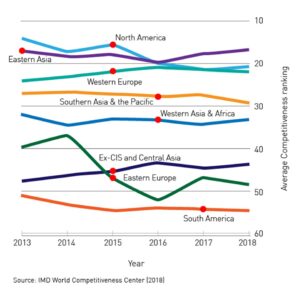
Will the most competitive countries in 2018 rank highest in talent?
The IMD World Talent Ranking will be released on 19 November (20:00 CET). It assesses how the 63 economies studied by the IMD World Competitiveness Center, attract and retain highly-skilled professionals. Cultivating a skilled and educated workforce is crucial to strengthening competitiveness and achieving long-term prosperity.
Here we look at the broad results of the 2018 IMD World Competitiveness ranking released in May of this year since data compiled during that report serves as a basis for the IMD World Talent Ranking.
As a whole, countries in the Asia & Pacific region continued to dominate IMD’s annual World Competitiveness Ranking – but not as much as they used to. The economies of Europe, Middle East & Africa are gaining on them. While the US came out on top this year, the Americas – notably Latin America – continue to decline, although there has been a slight improvement on last year’s ranking.
Of the 63 economies we examined in 2018, 31 improved their ranking, 24 went down and eight stayed the same. We scored all the countries on four main factors:
- Government efficiency, including governmental discipline with internal financing, the rule of law and the improvement of inclusive institutions
- Business efficiency, including productivity and efficiency of the private sector and ease of access to finance
- Economic performance, including international trade and international investment
- Infrastructure, including scientific infrastructure, health and environmental sustainability as well as education
Asia & Pacific does well on all of these, particularly economic performance, while its infrastructure comes in at the bottom.
The picture in Europe, the Middle East & Africa is the exact opposite: great at infrastructure, less so at economic performance. The Americas rank below the rest of the world in all these factors – although they are strongest, relatively, in business efficiency.
It’s useful to have a global view like this, but the regions each contain a wide range of countries with significant differences in their economic models (take Switzerland and Ukraine or Jordan and South Africa, for instance, countries with widely different ranks but included together in a region). The Americas include the highest ranked (the USA) and the lowest ranked (Venezuela) countries in competitiveness.
So, we’ve broken it down into sub-regions to make the ranking even more useful. The graph below shows how these sub-regions have been performing over the past six years:

Eastern Asia is the most competitive sub-region in 2018, having overtaken North America in 2016. Now North America and Western Europe are vying for second place, with North America just ahead. These three sub-regions represent the countries with the highest competitiveness.
The second group, the moderate-competitiveness countries, comprises Southern Asia & the Pacific (ranking fourth) and Western Asia & Africa (fifth).
The last group includes Eastern Europe, Ex-CIS and Central Asia, and Latin America. These include countries with ample room for improvement in their competitive standing.
Drilling down into the sub-regions’ performance in the four factors reveals some interesting details. North America dominates on economic performance. It’s the same story with business efficiency and infrastructure: led by North America with Western Europe and Eastern Asia close behind. But when it comes to government efficiency Western Europe is the highest ranked, despite criticism levelled at some European Union countries on their inefficient bureaucracies.
The sub-regions that rank lowest for competitiveness in almost all the factors are Western Asia & Africa, Ex-CIS & Central Asia, Eastern Europe and South America. The exception is Eastern Europe, which comes fourth overall in infrastructure. Notably, Latin America is the only sub-region with a star out-performer in government and business efficiency: Chile. In these factors it ranks closer North America and Southern Asia & the Pacific.
This year marked the 30th edition of the IMD World Competitiveness Ranking and our mission remains to help countries achieve prosperity and higher quality of life.
Will these results reflect which countries have the most competitive workforce in 2018?
Stay tuned for our World Talent Ranking, based on the competitiveness gathered during the compiling of this ranking, which will be released on 19 November 2018.
Research Information & Knowledge Hub for additional information on IMD publications
Despite geopolitical upheavals that threaten global growth, companies continue to see business opportunities across borders. As leaders strategize how to position their operations amid war, trade disputes, disease outbreaks, and climate change, ha...
in I by IMD
Research Information & Knowledge Hub for additional information on IMD publications
in I by IMD
Research Information & Knowledge Hub for additional information on IMD publications
in I by IMD
Research Information & Knowledge Hub for additional information on IMD publications
Research Information & Knowledge Hub for additional information on IMD publications
Research Information & Knowledge Hub for additional information on IMD publications
Research Information & Knowledge Hub for additional information on IMD publications
in I by IMD
Research Information & Knowledge Hub for additional information on IMD publications
in I by IMD
Research Information & Knowledge Hub for additional information on IMD publications
in I by IMD
Research Information & Knowledge Hub for additional information on IMD publications
Published by International Institute for Management Development ©2025
Research Information & Knowledge Hub for additional information on IMD publications










